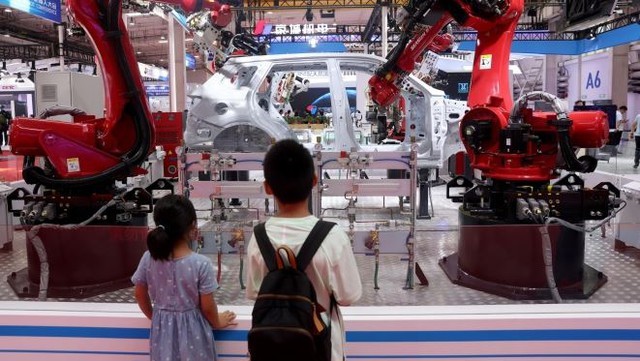Though CGXI has realized the dream of creating robots that manufacture robots, it has not achieved a high level of automation due to its small production volume. With funding from a public investment bank, the start-up is preparing to launch a brand new fully automated factory, deploying it as an “Industry 3.0” production line to optimize large-scale manufacturing.
According to the International Federation of Robotics (IFR), by 2022, China is set to deploy 290,000 industrial robots, which will account for over half of the total number of installed robots worldwide. China hopes this market will be worth $11.5 billion (around 10.7 billion euros) by 2024, as estimated by China Electronics Institute.
CGXI bets on the booming cobot market. Unlike large, cumbersome, and complex robots, these small robots can easily integrate into production lines and work harmoniously with humans. CGXI plans to gain a competitive advantage through its services and software.
“We are striving to create user-friendly cobots,” says founder Ji Feng.
Jiang Chao, founder and CEO of mobile robotics company Syrius, said that products manufactured in China have price advantages. For example, a Japanese competitor’s product costs 10,000 yen (68 USD) per kilogram of payload, while Syrius’ product is only half the price.

Automation at the factory reflects China’s significant transformation.
by replacing human workers with robots, given that China’s average worker age has increased, while wages continue to rise. In order to maintain its status as the world’s workshop, China has to change its approach.
The relevant authorities are well aware of this. As a result, dozens of supportive plans have been introduced at both the central and local levels. Since 2015, Guangdong, a major industrial province in southeastern China, has allocated a 950-billion-yuan plan ($123 billion euros) to “replace humans with robots”. Furthermore, the government also continued to announce the “Robot+” Action Plan at the beginning of 2023 to promote automation in most sectors of the economy, from industry to agriculture and healthcare.
With 322 robots per 10,000 workers, China ranks fifth in the world in terms of robot density, following South Korea (1,000 per 10,000), Singapore, Japan, and Germany.
According to The Economist, China is still persistently developing humanoid robots. In November 2023, the government announced plans to mass-produce these products by 2025. Around half of the industrial robots installed worldwide were made in China in 2022, as reported by the International Federation of Robotics.
Many of China’s newly installed robots are mechanical arms that are programmed to weld, drill, or assemble components on the production line. In 2022, China produced more than 6 million service robots, which assist humans in performing various tasks. For example, in a restaurant, customers are served by robots.

China-made robots are rapidly gaining market share in Asia, North America, Europe, and the Middle East.”
In reality, the average age of farmers in China is over 50 years. Very few young people want to work on farms. Some countries facing similar issues often have to import food or hire cheap labor. For China, robots may be a suitable solution.
According to KR Asia, China-made robots are rapidly gaining market share in Asia, North America, Europe, and the Middle East. According to data from the Korea Robot Industry Association, as of 2022, over 70% of service robots in Korea are produced on the mainland.
Since the introduction of the Made in China 2025 initiative, Beijing has set a goal of replacing imported robots with domestically-produced ones. According to the MIR Databank, local manufacturers have more than doubled their market share from 17.5% in 2015 to 35.5% in 2022. In 2016, Chinese home appliance manufacturer Midea spent 4.5 billion euros to acquire German robot company Kuka, illustrating its aspirations.
“Many electric vehicle brands are becoming more open to domestic supply chains. Some are testing Chinese robots despite some limitations. BYD alone purchased 20,000 robots in 2022, including 1,000 cobots from competitor CGXI,” said Wang Feili, a machine tool expert at UBS Securities.
Source: The Economist, Le Monde












